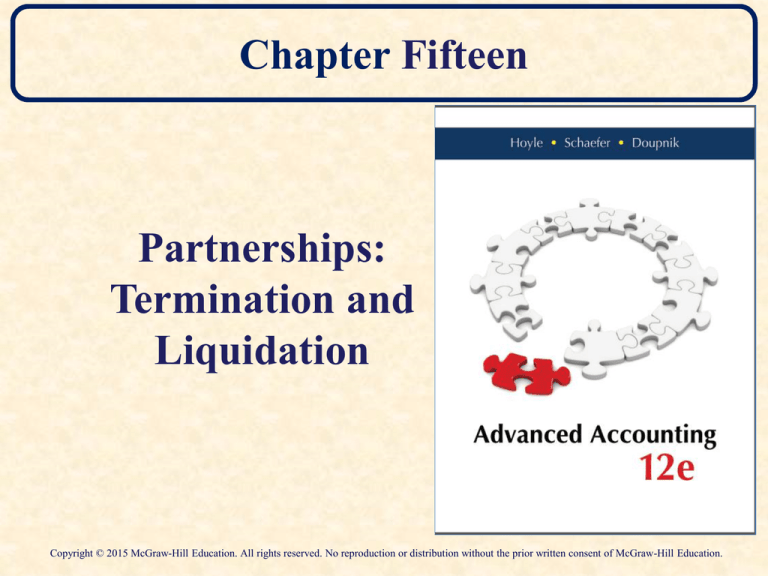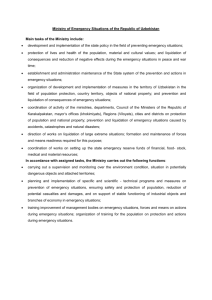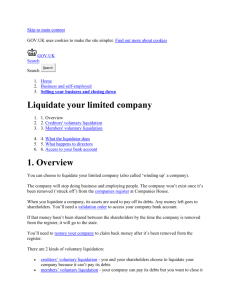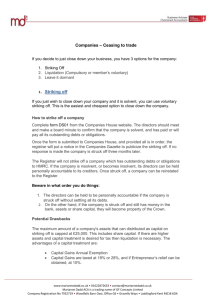
Chapter Fifteen
Partnerships:
Termination and
Liquidation
Copyright © 2015 McGraw-Hill Education. All rights reserved. No reproduction or distribution without the prior written consent of McGraw-Hill Education.
Termination and Liquidation
The liquidation of a partnership generally involves three
important steps:
1. Non‐cash partnership assets are sold for cash, and gains
and loss on the sales are allocated to the capital accounts
of individual partners on the basis of the profit and loss
ratios.
2. Partnership liabilities and expenses incurred during the
liquidation are paid out of the partnership’s available
cash.
3. Any partnership cash remaining after paying liabilities
and liquidation expenses is distributed to the individual
partners on the basis of their respective capital balances.
15-2
Termination & Liquidation
The accountant summarizes and keeps track of the process
in a statement of partnership liquidation.
The liquidation of a partnership becomes complicated if:
• One or more partners have a negative (deficit) capital
balance.
• The liquidation takes place over an extended period of
time.
The accountant can facilitate distribution of cash in
installments by calculating the safe payments.
The accountant might prepare a cash predistribution plan.
15-3
Learning Objective 15-1
Determine amounts to be paid
to partners in a liquidation.
15-4
Termination & Liquidation
To liquidate a partnership, the process calls for:
1) Assets converted into cash to pay business
obligations and liquidation expenses.
2) Remaining assets distributed to partners
based on their final capital balances.
3) Partnership books closed.
15-5
Learning Objective 15-2
Prepare journal entries to
record the transactions
incurred in the liquidation of
a partnership.
15-6
Termination & Liquidation Example
On 6/1, inventory is sold for $15,000.
Note the loss on the sale of inventory of $7,000 is assigned
$4,200 ($7,000 x 60%) to Morgan and $2,800 ($7,000 x
40%) to Houseman.
15-7
Termination & Liquidation Example
$9,000 of the Accounts Receivable are collected. Remaining
accounts receivables are written off, and the loss is allocated
between Morgan (60%, $1,800) & Houseman (40%, $1,200).
Fixed assets are sold for $29,000. The loss of $12,000 is allocated
to Morgan (60%, $7,200) & Houseman (40%, $4,800).
15-8
Termination & Liquidation Example
Once assets are sold and accounts payable paid, the partnership
incurs an additional $3,000 in liquidation expenses.
After calculating ending capital balances, the remaining cash is
distributed to the partners to close out the financial records.
15-9
Learning Objective 15-3
Determine the distribution of
available cash when one or
more partners have a deficit
capital balance or become
personally insolvent.
15-10
Deficit Capital Balance
Deficit balances can be resolved two ways:
Deficit partner can make a contribution to cover
deficit.
Remaining partners can absorb the deficit.
Allocation of the loss is based on the relative profit
and loss ratio specified in the articles of partnership.
A safe payment may be made to partners that
reduces that partner’s capital account to the
minimum dollar level.
safe payments can be distributed to the partners
without creating new deficits.
15-11
Learning Objective 15-4
Prepare a proposed schedule of liquidation
from safe capital balances to determine an
equitable preliminary distribution of
available partnership assets.
15-12
Preliminary Distribution of Assets
Under the Uniform Partnership Act, a priority ranking
of creditors having claims against individual partners is
recognized:
Debts owed to
partnership
creditors.
Debts owed to
the other
partners.
Debts owed to
personal
creditors.
15-13
Claims Against the Partnership
Individual partner’s creditors can make a claim
against the assets of the partnership.
All partnership creditors must be satisfied first.
The creditors can only assert claims to the extent of
the specific partner’s positive capital balance.
Each partner is liable for ALL the debts of the
partnership.
Partners are NEVER liable for the personal debts of
the other partners.
15-14
Learning Objective 15-5
Develop a predistribution plan to guide the
distribution of assets in a partnership
liquidation.
15-15
Predistribution Plan
At the start of a liquidation, accountants produce a
single predistribution plan to serve as a guide for all
future payments.
Whenever cash becomes available, the plan indicates
the appropriate recipient(s) without drawing up everchanging proposed schedules of liquidation.
The plan is developed by simulating a series of losses,
each of which is just large enough to eliminate, one at
a time, all of the partners’ claims to partnership
property.
15-16
Predistribution Plan
As a prerequisite to developing a predistribution
plan, the sensitivity to losses exhibited by each of
these capital accounts must be measured.
Determine the maximum loss that each partner can
absorb.
Divide each partner’s capital balance by their
respective income sharing percent.
Once a partner’s maximum loss is absorbed, new
balances are computed until all losses are absorbed.
15-17
Predistribution Plan
To inform all parties of the pattern by which
available cash will be disbursed, the
predistribution plan should be formally prepared
in a schedule format prior to beginning liquidation.
15-18






